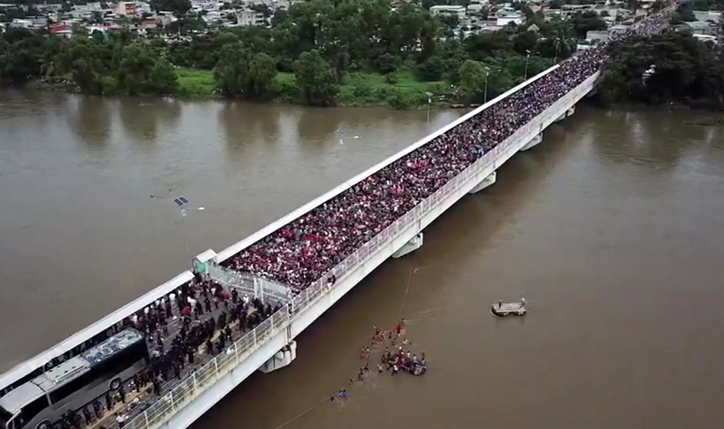In November 2018 a group of organised migrants - a so-called ‘migrant caravan’ - crossed Mexico City. Many of them began their journey in Honduras and headed for the United States. By early 2019, the caravan had reached the northern border city of Tijuana where Barretal, a refugee camp-like site, was set up by the Mexican government.
The Barretal site served as a mechanism to provide humanitarian assistance whilst exercising control of migrants, many of whom then sought asylum in the U.S.A. By late 2019, the United States and Mexican governments agreed to enforce the Migrant Protection Protocols (MPP) or “Remain in Mexico” programme as it is commonly known, through which migrants seeking asylum in the U.S.A. were forced to wait in Mexico. Over 60,000 asylum seekers were returned to Mexico via this programme, including many of the original members of the 2018 caravans. Migrants crossing Mexico headed for the U.S.A. often endure long journeys in pursuit of their goals and the “American dream”, only to face closed doors and rejection. And yet, while this experience can be disempowering, research has shown that organised migrants are a force for negotiation and resistance.
The mobilisation of the 2018 migrant caravans quickly became a matter of national security in Mexico and the U.S.A. Through various means, governments attempted to deter migrant journeys to the north. The former U.S. president Donald Trump publicly requested the Honduran government stop the caravan, threatening Honduras with financial aid cuts. Shortly after this warning the former Honduran president, Juan Orlando Hernandez, urged Honduran members of the caravan to abandon their plans to migrate as part of the collective.
The Mexican government, faithful to its tradition of subordinating to its northern counterpart on issues of migration, prepared mechanisms to contain the caravan by protecting Mexico’s southern border. Hundreds of members of the newly funded military force The National Guard were sent to uphold this border. This engagement of the military has resulted in numerous human rights violations including unlawful deportations and arbitrary detentions – which have been highlighted by several non-governmental organisations. Human rights defenders, migration scholars, and civil society members have reported that successive U.S. governments have heavily influenced Mexico’s actions in response to the organised mobilisation of migrants.
Mexico’s geographical position has meant the country has been used by the U.S.A. as a buffer and external border between Latin America and the USA. Similar to Turkey’s position with Syria, Mexico has been used as a ‘safe third country,’ where asylum seekers wait for their status determination. However, Mexico is not necessarily safe. The nation now has one of the highest homicide rates worldwide and numerous organisations have reported the horrific risks migrants face when they are returned to Mexico.
There have been numerous reports of discriminatory practices and xenophobic incidents toward migrants from some of the local populations and even public servants such as police in transit areas. Some have suggested that this is linked this to the hostile institutional responses of the U.S.A and Mexico - both geared towards national protection. Nevertheless, numerous other cases have seen locals assist migrants, often providing emergency aid, food, shelter and medicines to meet the needs of those in transit.
But the story of the migrant caravans is a story of strength, not just of vulnerability. Despite migrants facing inequalities and abuse, as agents, they also resist and advance personal agendas to reach their goals. The migrant caravans are illustrative examples of migrant-led political organisation and the exercising of collective power. Such dynamics may lead to processes of empowerment or the “expansion of agency”. The organisation of migrants in this way may signal a process of development of critical consciousness (conscientização in Freire’s terms) which enables individuals to move from a stage of reflection and understanding to a stage of acting to transform oppressive power relations. In the face of restrictive migration policies; the operation of criminal groups throughout migratory routes; and the precarity experienced in origin and transit countries; migrants appear to have identified that more can be accomplished by a collaborative group than by isolated individuals – thus achieving a shared goal and realising their collective power.
The migrant caravans of 2018 and 2019 may be an illustration that the mythical “American dream” continues to have a significant hold over the imaginations of many struggling against poverty and oppression in Central and Latin America. However, the caravans demonstrate migrant processes of self-reflection and self-recognition as a collective population entitled to human rights. That said, migrant organised mobilisation and expansion of agency was - and is – still limited. It is ultimately circumscribed within the limits of formal and informal powers which determine the type of route choices available.
Therefore, when thinking of migrant empowerment, it is important to consider the structures that shape collective and individual exercising of agency. It is crucial to critically assess how the ongoing migration regime and its implementation in the Americas externalises borders, produces forced immobility, exacerbates migrants’ vulnerability, and hinders opportunities for empowerment. And yet, power relations are never one-directional. Where there is oppression, there will be resistance. The collective exercising of power by the 2018 and 2019 migrant caravans serves as an example of a migrant’s capacity to push back and protect what is rightfully theirs: free movement, peace and dignity.
